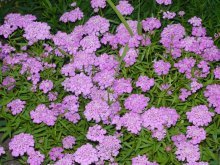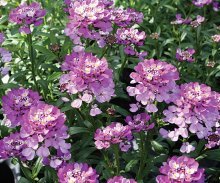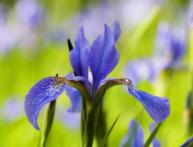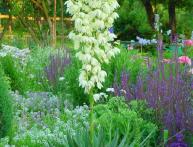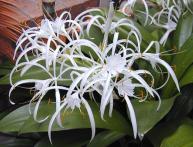Iberis umbrella: description of the plant and rules of care
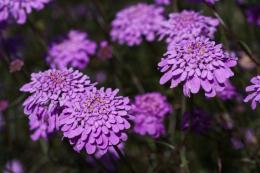
Iberis is a plant that gets its name from the ancient name of the Iberian Peninsula. In ancient times it was called Iberia. This is the southernmost of the European peninsulas, apparently plants were discovered here, which were later attributed to the genus Iberis. The genus includes about 30 species, including Iberis umbellata, which is widespread in gardens.
Content:
- Iberis umbellata, description of the species
- Choosing a location and planting Iberis, care features
- Application of Iberis umbellata
Iberis umbellata, description of the species
At first glance at the plant Iberis umbellata, one can hardly understand that this is the closest relative of plants such as turnips or cabbage vegetable garden Iberis umbellata is widespread in Europe, southern Russia, and the Caucasus. In gardens it is most often represented as an annual herbaceous form. The plant has a tap root. The height of the stems is from 15 to 40 cm. The stems of the plant are smooth, mostly bare, with pronounced branching.
The flowers are small, have 4 petals, and are collected in fairly dense umbrella inflorescences. The size of one inflorescence can be up to 5 - 6 cm in diameter. In summer, due to the many simultaneously opened flowers, the impression of a continuous cloud is created, especially if the variety has snow-white flowers. The color of the petals, in addition to white, can be:
- lilac
- purple
- pink
- purple
- lilac
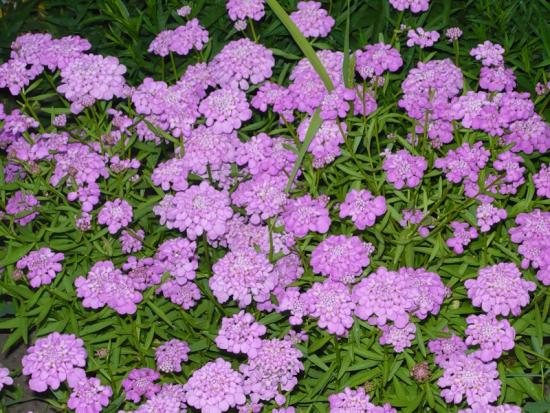
In landscape design Iberis umbellata is used in a variety of compositions.It looks good as a border or ground cover plant. Used in mixed flower beds, group plantings, alpine slides, rocky gardens, along with conifers and flowering shrubs. Suitable for designing paths and natural slopes.
Combines with cineraria, alyssum, herbal cloves. Currently, several cultivated varieties of Iberis have been developed. All of them have interesting inflorescences and romantic names. Among the varieties of Iberis umbellata, the following look gorgeous:
- Pearl scattering is an unpretentious stable variety with white flowers that have a very pleasant smell
- Fianit - the variety has quite large, up to 6 cm in diameter, inflorescences of a delicate pink color, blooms for 8 - 9 weeks, starting from the second half of June
- Blackberry meringues - bushes 25 - 30 cm high, inflorescences up to 5 cm in diameter, all shades from white to dark, the color of blackberry jam
- Pomegranate ice - a contrasting mixture with snow-white and dark garnet inflorescences, has a delicate but strong aroma, like all types of ibris, an excellent honey plant
- Liliciana - bush height 20 cm, soft purple inflorescences, honey aroma
If the variety is chosen, then it remains to be seen how difficult it is to plant and grow Iberis umbellata on the site.
Choosing a location and planting Iberis, care features
Landing site requirements
Iberis umbrella loves open sunny places; it also grows well in partial shade. You should not place it in full shade, as this may reduce the decorative effect. He is not at all picky about the choice of soil. Strongly acidic heavy soils with stagnant moisture should be avoided. Loamy and sandy loam soils with a reaction close to neutral or slightly acidic will be preferable for growing Iberis umbellata.
Iberis propagates by seeds, dividing bushes
Since the plant does not tolerate transplantation very well, the easiest way to propagate in amateur floriculture is to plant seeds in open ground. It is important to remember that when growing several varieties, especially hybrid forms, mutual pollination of plants occurs. As a result, Iberis loses its varietal color. If you plant with self-collected seeds, you can most often get bushes with white or pale purple flowers.
To have beautiful varietal plants, it is best to purchase seed material from a retail chain. Iberis umbellata seeds remain viable for up to three years.
Planting Iberis umbellata in the ground
The best time for planting in open ground is spring. You can start sowing in the second half of April - early May. It is advisable that daytime temperatures settle at + 16 +18. Seeds are planted in prepared soil to a depth of 5 - 7 mm. Deeper embedding is not advisable.
Taking into account the fact that the plant forms a fairly lush bush, the distance between the seeds should not be less than 20 cm. After 10 - 14 days, shoots appear. At this time, plants need watering. Such plants bloom after 35 - 40 days. To achieve earlier flowering, Iberis can be sown before winter in September.
Features of caring for Iberis
Like all cabbage crops, the seedlings of these flowers can be damaged by the cabbage flea beetle. To repel it, plants can be dusted with wood ash. Prevention from pest attacks can be done by sowing at an earlier date.

Also, you should not allow the soil to dry out, otherwise the plant may begin to wither and dry out; only timely watering will return the plantings to a healthy appearance. To extend the flowering period, you need to cut off old inflorescences, preventing the formation of seeds. In addition to their pleasant appearance and smell, plants have practical uses.
Application of Iberis umbellata
First of all, Iberis umbellata is an excellent plant for an apiary, as it is very attractive to bees. Given the long flowering period, bees can take bribes almost all summer. The plant is used in folk medicine as a medicinal plant. The above-ground parts of Iberis umbellata contain useful substances:
- quercetin
- glycosides
- cucurbitocin
- kaempferol
- esters
Iberis tincture helps with heart disease. Also, decoctions from it have choleretic properties, ease the course of gastrointestinal diseases, and relieve swelling. You can gargle with a water infusion for sore throats. The decoction can be used to heal wounds in the form of lotions. Iberis The umbrella plant is not only good for garden decoration, but also has benefits for humans.
Video review of the Iberis flower:

